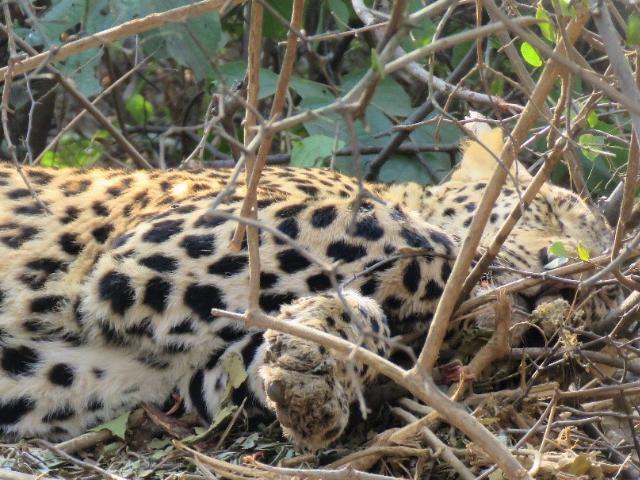Leopards,dead or alive, seem to have been continuously creating hurdles in the ambitious cheetah translocation project.Now poaching of a leopard from Kuno National Park created a sensation as the incident was reported at a time when the park is getting ready for the cheetah project .In fact it has happened when a large number of forest department personnel are engaged inside the park in catching three leopards from an enclosure earmarked for cheetahs to be translocated from Africa. The Special task force (STF) of MP Forest department has rounded up tribals accused of leopard killing. This has also raised questions over safety of the wildlife in Kuno.
Wire Snare In Kuno Kills Leopard
Also read: Are Leopards ,Tigers Threat To Cheetahs Coming To Kuno ?
Soon the STF personnel from Bhopal rushed to Kuno. After initial investigations, five tribal of Bhilala tribe were arrested. The leopard nails and whiskers among other body parts were also recovered, sources confirmed. “Further interrogations were on to extract more information from them. This is the fourth such incident in the past two years. We suspect involvement of some gang of poachers”, sources said. If a tiger or leopard is killed in retaliation for the killing of cattle, the body parts are never removed. Body parts like nails and whiskers are removed only for sale, they said. “And the paws are removed along with nails to prove the authenticity of nails. It fetches more money”, sources said. Hunting of wildlife using wire snares is one of the severest threats in India and many other parts of the world.
Poaching Case Raises Eye Brows
The incident has come to light at a time when the country was busy in an international project of translocation of cheetahs on Kuno, originally planned as a second home to lions. “ It is a huge embarrassment also”, officials admit. After Kuno was identified as a jungle for the introduction of cheetahs from South Africa and Namibia, 5 square km enclosures were created for housing cheetahs. Earlier this month, the park management found five leopards present in one of the enclosures. With the high density of leopards in Kuno, there is a presence of 8 to 10 leopards on every 100 sq kms area of the forest according to the 2018 census. A team comprising officials of the Union ministry of environment forest and climate change and Madhya Pradesh forest department among others have been able to catch 2 leopards. Large number of camera traps were installed to get the images of the leopard’s .Earlier this month, two elephants were deployed to catch the remaining three leopards but so far the cats continue to evade the forest force.
Also read: Cheetah Races For Kuno, Defeats Lion
India is estimated to have 12,852 leopards. Highlighting the status of its conservation concerns, it was recently revised on the IUCN Red List to “Vulnerable”. The spotted cat is also listed under Schedule-I of the Wildlife Protection Act giving them the status of highest priority for conservation under the Wildlife Conservation Act 1972. Some of the threats posed to leopards include poaching for body parts, mortality due to vehicular collisions, habitat loss, retaliatory killing, and others, said a study “Quantifying Wire Snares as a Threat to Leopards in Karnataka, India." The study was conducted by three researchers -Sanjay Gubbi, Aparna Kolekar, Vijaya Kumara. Snaring, one of the simplest and most effective hunting techniques, impacts other non-target species like the leopard,” the study said adding, “We document the spatial and temporal trends of snaring of leopards from India.”




Comments
Post a Comment